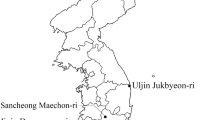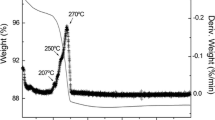Abstract
IN many parts of the world, especially in those that were not glaciated during the Pleistocene epoch, red hematitic soils that formed in a previous climate (different from the present one) still exist. In regions where the present climate is cooler and more humid than the previous one, the red colour seems to be disappearing and being replaced by more yellowish-brown colours that indicate the mineralogical transformation of hematite (α-Fe2O3) to goethite (α-FeOOH).
Similar content being viewed by others
References
Daniels, R. B., et al., Soil Sci. Soc. Amer. Proc., 34, 648 (1970).
Matsui, T., Proc. Seventh Cong. Quaternary Soils, 9, 222 (1967).
Maud, R. R., J. Soil. Sci., 16, 60 (1965).
Schwertmann, U., Fortschr. Mineral, 46, 274 (1969).
Fischer, W. R., thesis, Tech. Univ. Munich (1971).
Radoslovich, E. W., J. Soil. Sci., 9, 242 (1958).
Walker, T. R., Geol. Soc. Amer. Bull., 78, 353 (1967).
Norris, R. M., J. Sed. Petrol., 39, 7 (1969).
Author information
Authors and Affiliations
Rights and permissions
About this article
Cite this article
SCHWERTMANN, U. Transformation of Hematite to Goethite in Soils. Nature 232, 624–625 (1971). https://doi.org/10.1038/232624a0
Received:
Revised:
Issue Date:
DOI: https://doi.org/10.1038/232624a0
- Springer Nature Limited
This article is cited by
-
Orbital pacing and secular evolution of lake-level changes reconstructed by sedimentary noise modeling during the Early Jurassic icehouses-(super)greenhouses
Science China Earth Sciences (2024)
-
From desert to monsoon: irreversible climatic transition at ~ 36 Ma in southeastern Tibetan Plateau
Progress in Earth and Planetary Science (2022)
-
Oligocene moisture variations as evidenced by an aeolian dust sequence in Inner Mongolia, China
Scientific Reports (2022)
-
The study of mineral mapping in black soil using TASI thermal infrared data, taking the Baiquan area of China as an example
Earth Science Informatics (2022)
-
The influence of CO2-transformed iron oxide grain coatings on the frictional stability and transport properties of simulated faults in sandstones
Geomechanics and Geophysics for Geo-Energy and Geo-Resources (2020)





